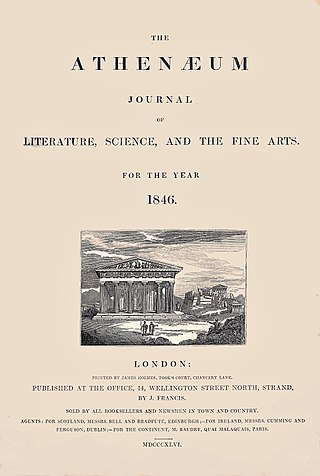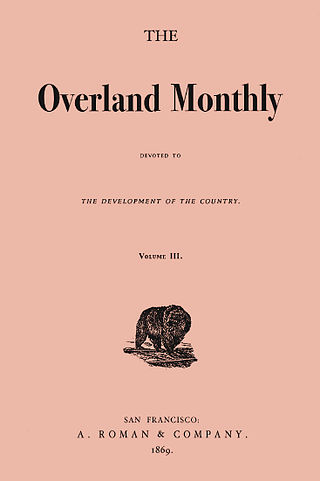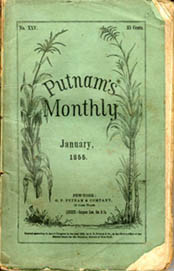
Typee: A Peep at Polynesian Life is American writer Herman Melville's first book, published in 1846, when Melville was 26 years old. Considered a classic in travel and adventure literature, the narrative is based on Melville's experiences on the island Nuku Hiva in the South Pacific Marquesas Islands in 1842, supplemented with imaginative reconstruction and research from other books. The title comes from the valley of Taipivai, once known as Taipi.

The Bookman was a literary journal established in 1895 by Dodd, Mead and Company
"Bartleby, the Scrivener: A Story of Wall Street" is a short story by the American writer Herman Melville, first serialized anonymously in two parts in the November and December 1853 issues of Putnam's Magazine and reprinted with minor textual alterations in his The Piazza Tales in 1856. In the story, a Wall Street lawyer hires a new clerk who, after an initial bout of hard work, refuses to make copies or do any other task required of him, refusing with the words "I would prefer not to."

The Century Magazine was an illustrated monthly magazine first published in the United States in 1881 by The Century Company of New York City, which had been bought in that year by Roswell Smith and renamed by him after the Century Association. It was the successor of Scribner's Monthly Magazine. It was merged into The Forum in 1930.

The Athenæum was a British literary magazine published in London, England, from 1828 to 1921.

The London Magazine is the title of six different publications that have appeared in succession since 1732. All six have focused on the arts, literature and miscellaneous topics.
The Yale Review is the oldest literary journal in the United States. It is published by Johns Hopkins University Press.

Studies in Classic American Literature is a work of literary criticism by the English writer D. H. Lawrence. It was first published by Thomas Seltzer in the United States in August 1923. The British edition was published in June 1924 by Martin Secker.

The Delineator was an American women's magazine of the late 19th and early 20th centuries, founded by the Butterick Publishing Company in 1869 under the name The Metropolitan Monthly. Its name was changed in 1875. The magazine was published on a monthly basis in New York City. In November 1926, under the editorship of Mrs. William Brown Meloney, it absorbed The Designer, founded in 1887 and published by the Standard Fashion Company, a Butterick subsidiary.

The Overland Monthly was a monthly literary and cultural magazine, based in California, United States. It was founded in 1868 and published between the second half of the 19th century and the first half of the 20th century.

Evert Augustus Duyckinck was an American publisher and biographer. He was associated with the literary side of the Young America movement in New York.
The Piazza Tales is a collection of six short stories by American writer Herman Melville, published by Dix & Edwards in the United States in May 1856 and in Britain in June. Except for the newly written title story, "The Piazza," all of the stories had appeared in Putnam's Monthly between 1853 and 1855. The collection includes what have long been regarded as three of Melville's most important achievements in the genre of short fiction, "Bartleby, the Scrivener", "Benito Cereno", and "The Encantadas", his sketches of the Galápagos Islands.

Cornelius Mathews was an American writer, best known for his crucial role in the formation of a literary group known as Young America in the late 1830s, with editor Evert Duyckinck and author William Gilmore Simms.
"The Encantadas, or Enchanted Isles", is a novella by American author Herman Melville. First published in Putnam's Magazine in 1854, it consists of eleven philosophical "Sketches" on the Galápagos Islands, then frequently known as the "Enchanted Islands" from the treatcherous winds and currents around them. It was collected in The Piazza Tales in 1856. The Encantadas was a success with the critics and contains some of Melville's "most memorable prose".
The New Monthly Magazine was a British monthly magazine published from 1814 to 1884. It was founded by Henry Colburn and published by him through to 1845.
The Massachusetts Magazine was published in Boston, Massachusetts, from 1789 through 1796. Also called the Monthly Museum of Knowledge and Rational Entertainment, it specialized in "poetry, music, biography, history, physics, geography, morality, criticism, philosophy, mathematics, agriculture, architecture, chemistry, novels, tales, romances, translations, news, marriages, deaths, meteorological observations, etc. etc." It was intended as "a kind of thermometer, by which the genius, taste, literature, history, politics, arts, manners, amusements and improvements of the age and nation, may be ascertained." Founded by Isaiah Thomas, the magazine was also published by Ebenezer T. Andrews (1789-1793), Ezra W. Weld (1794), Samuel Hill (1794), William Greenough (1794-1795), Alexander Martin (1795-1796), Benjamin Sweetser (1796), and James Cutler (1796). It was edited by Isaiah Thomas, Thaddeus Mason Harris (1795-1796), and William Bigelow (1796). Contributors included Joseph Dennie, William Dunlap, Benjamin Franklin, Sarah Wentworth Morton, Judith Sargent Murray, and Christian Gullager. Sheet music was published with some issues, including compositions by Hans Gram.

The bibliography of Herman Melville includes magazine articles, book reviews, other occasional writings, and 15 books. Of these, seven books were published between 1846 and 1853, seven more between 1853 and 1891, and one in 1924. Melville was 26 when his first book was published, and his last book was not released until 33 years after his death. At the time of his death he was on the verge of completing the manuscript for his first novel in three decades, Billy Budd, and had accumulated several large folders of unpublished verse.
"Cock-A-Doodle-Doo! or, The Crowing of the Nobel Cock Beneventano" is an 1853 short story by the American writer Herman Melville. It was first published in the December 1853 issue of Harper's Magazine, the same month the second installment of "Bartleby, the Scrivener" appeared in Putnam's. The story remained uncollected until 1922, when Princeton University Press included it in The Apple-Tree Table and Other Sketches.
Blanche Lucile Macdonell (1853–1924) was a Canadian author and folklorist, whose writing was described as 'full-blooded and instinct with Canadian life and thought.'
Emma Miller Bolenius was an American educator and textbook writer.











